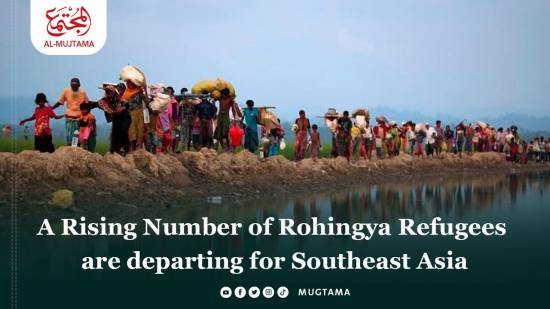A Rising Number of Rohingya Refugees are departing for Southeast Asia
While some people depart by land from Bangladesh to Thailand, others set out on perilous and even fatal ocean expeditions.
Refugees from the Rohingya ethnic group are increasingly taking perilous treks to Southeast Asia in order to flee the risks of an uncertain life in the camps in eastern Bangladesh.
In early December, around 150 such refugees were stranded at sea off Thailand’s coast after their boat broke down. Rights activists suspect that many may have died and requested the country’s authorities to rescue the survivors.
The episode came on the heels of a number of similar incidents to have occurred intermittently over the past two years. Late in 2021, for instance, there was a standoff involving a boat carrying Rohingya refugees and the Indonesian navy, which ended after 18 hours with a rescue of the refugees by the navy.
The trail to Southeast Asia and the Middle East from refugee camps in Bangladesh and the Rohingya-inhabited region of Myanmar’s Rakhine State began decades ago after the Myanmar military launched Operation Dragon King (Nagamin) against Rohingya in the late 1970s.
Several more military operations followed in the decades thereafter, compelling hundreds of Rohingya to relocate to Bangladesh and other countries. The biggest exodus was in 2017 when the Myanmar military launched attacks that forced more than 700,000 people to cross the border into Bangladesh, where most now remain.
The Rohingyas, a Muslim minority group living predominantly in Rakhine State, are often described as the world’s most persecuted people. They have been at the receiving end of institutionalized discrimination and repression by Myanmar’s ethnic Bamar-dominated military.
Conversations over the telephone with three Rohingya refugees rehabilitated at different camps in Cox’s Bazar, Bangladesh, revealed details of the immigration to overseas destinations in Southeast Asia that could continue in the future.
“People are continuously escaping from the camps in Cox’s Bazar. The numbers keep on changing but it could be somewhere between 50 and 100 people every day who leave for Southeast Asia,” claimed a refugee in his early 30s. “It is likely that more people are exiting from the camps in Bangladesh than from the Rohingya inhabited zone in Myanmar’s Rakhine State.”
Emigration has picked up dramatically after the first wave of the COVID-19 pandemic began to recede around two years ago. The journey is arranged by a network of brokers who are active in a majority of the 34 refugee camps in Cox’s Bazar and the Rohingya region in Rakhine State. But only the families who can cough up the exorbitant rates demanded by the brokers can hope to depart for Southeast Asia.
According to the refugees, the current rate charged by the brokers is around $4,800- $5,800 per person. On many occasions, families sell all their belongings to obtain the necessary funds, which can also be paid in instalments. But that is not the end of the story. Sometimes the brokers employ a range of tactics to extract more money from the families before they are allowed to depart.
One refugee recalled an instance in which a broker forcibly separated a child from his parents and detained him near Sittwe, the state capital of Rakhine State, for many days as he wanted more money. The family was allowed to proceed further in the journey only after his demands were fulfilled.
Brokers hand over every group to other brokers at specific destinations on the two routes through which the refugees are ferried. The overland route originates at Teknaf and passes through Maungdaw and Sittwe in Rakhine State and then onward to Thailand overland via Ayeyarwady Division.
Photographs that are in circulation at some camps in Cox’s Bazar reveal that refugees are usually herded beneath the merchandise in trucks that ply the route between Yangon and Ayeyarwady Division. On November 27, a truck transporting many refugees hidden beneath sacks of ginger skidded off the road near Yangon. A few days later, the bodies of 13 men, most of them teenagers, were found dumped near Ngwe Nanthar village in Hlegu township.
Many groups of Rohingya refugees have been detained in Ayeyarwady over the past several months. According to an estimate, more than 400 refugees were sent to prison in the region since the military coup in Myanmar early in 2021.
The other route is by sea on rickety boats to various countries in Southeast Asia. Most of the escapees prefer Malaysia to other countries owing to its government’s past leniency toward Rohingya refugees (though this may be changing). Harrowing tales had surfaced about the experiences of refugees after reaching Thailand, where they have been imprisoned or forced into bonded labour unless more funds are paid.
More than 1 million Rohingya refugees are lodged at the camps in Cox’s Bazar.] An uncertain future coupled with the squalid conditions in the camps here has prompted an increasing number of refugees to undertake hazardous journeys to Southeast Asia.
The refugees alleged that despite active support from several NGOs, education and health facilities at all the camps have been improved, but they are still insufficient for the full population of Cox's Bazar. They bemoaned the fact that there aren't many jobs available in Bangladesh, which has led to more adults and young people leaving the camps in search of safer pastures.


